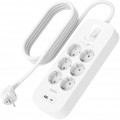Max. power
The highest power consumption of the connected devices that the surge protector can tolerate without consequences (to be more precise, with which it can work indefinitely without overloads, overheating, etc.).
This limitation is due to the fact that the higher the power at the same voltage, the higher the current passing through the equipment (in this case, through the surge protector); and off-design currents can lead to breakdowns and even accidents. And although in order to avoid these consequences, modern filters often provide various types of protection (see above), however, the operation of protection is still an emergency situation that is best avoided. Therefore, it is worth choosing a model according to this parameter in such a way that the maximum filter power is at least not lower than the total power consumption of the load. And it is best to have a margin of 20 – 30% — this will give additional guarantees in case of various deviations in the operation of the connected equipment.
Separately, it is worth highlighting the situations when the filter is planned to be used for the so-called reactive load — electrical appliances that widely use circuits on capacitors and/or inductors, for example, power tools or refrigeration units. The total power consumption of such devices (written in volt-amperes) can be much higher than the active power (which is indicated in watts). The recommended line filter power in such cases is calculated using special...formulas that can be found in the relevant sources.
Max. energy absorption
The maximum energy absorption provided by the mains filter, namely, the maximum pulse energy at which the device can safely absorb and dissipate it, completely protecting the connected load. The higher this indicator, the more reliable the filter, the more powerful power surges it can handle. In inexpensive models, the maximum absorption is calculated in tens of joules, in the most advanced models it can exceed 1000 J and even 2000 J.
Grounded sockets (type F)
The number of
sockets with type F grounding, provided in the design of the mains filter.
In this case, we are talking about full-size European type F sockets with metal ground clamps on both sides at the edges of the socket. The "socket" in this case means a CEE 7/4 ("Schuko") standard plug. Grounding is required for the safe operation of some types of electrical appliances, in particular, washing machines and other machines that work with water, refrigerators, computers, audio equipment, etc. A detailed list can be found in the reference literature. If you plan to connect such devices through the filter, this filter must have sockets with grounding.
Outlets location
Options for placing sockets on the body of an extension cord or surge protector.
-
Along the hull. Devices with the layout of sockets in one slender line, which is extended along the entire body of the extension cord or surge protector.
-
In 2 rows. A popular scheme with the arrangement of sockets in 2 rows is on both sides of the upper plane of the device housing.
-
In a circle. This category includes all extension cords and surge protectors with sockets in the form of a full circle or a semicircle.
-
On both sides of the body. Sockets on several side faces of the case are found in compact cube models and in advanced surge protectors with relocated sockets on both sides of the case, which makes it easy to connect a large number of consumer devices.

